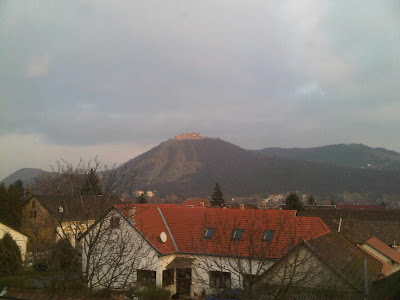 |
| The Castle at Kaiserwerth, or what's left of it. |
Let's talk a bit about castles. There used to be one downriver from the Dorf. It's a ruin now, thanks to the Napoleonic troops who blew it up to deny the German states any fortification that would have helped them retake the Rhineland.
But in its hey day, after it was built by Frederick Barbarossa, it had the distinction of being one of his key castles on the Rhine. It guarded the Rhine River and exacted tolls from boats passing by. It's good business for the castle owner: you just sit and wait for the next boat to float by.
And! It was easy to reach. It is just sitting on a bike path, upriver from Düsseldorf – a cool 45-minute bike away.
When you put in perspective, it's incredible that a stone building has survived in some shape or form for 1000 years. Yet, it's a common sight, even in Hungary, where they were built with a different purpose in mind.
Picture this: It's year 1285 and you're a Hungarian peasant going about your business, when that business is interrupted by thousands of Mongol horsemen burning and killing as they go.
Your only hope as a peasant without a horse is to hide behind a high wall, like that of a castle. But there are no castles close to you, so you're dead now.
When the Mongol hordes came tearing into Hungary, they found a flat, nearly defenceless land, perfect for their mounted warriors. Other than a Hungarian army of knights and infantry, which they handily defeated with their mounted cavalry, there was nothing to stop them.
The Hungarians – who centuries before, like the Mongols, lived on horseback and rode to Europe from Central Asia – noticed that cities and fortresses with high stone walls survived the onslaught. Anticipating a Mongol return, they built castles all over the land and waited.
The Mongols returned, but they couldn't breach the castles with horses and arrows. The Hungarians waited and watched them ride past, then attacked and defeated the Mongols.
SIDE NOTE!! The Hungarian word for waiting and castle is var, and I'm certain that there's a connection between the two. In Germany, which didn't have to wait for terrifyingly apocalyptic Mongol invasions to come to them, large prosperous towns grew around their castles. It's no coincidence that burg is the German word for castle and town, think Magdeburg or Salzburg.
Where was I... oh yes, Hungary! All seemed fine for about 400 years or so when the Hungarians lost the Battle of Mohacs to the massive Ottoman Turk army. The survivors retreated to their castles and awaited the onslaught.
The Ottomans – 300,000 of them – moved northwest, fighting a long, grinding 70-year war, assaulting castle after castle. Some withstood the assaults, like Eger, but many fell one at a time.
What's amazing is that most of these castles survived the Turkish invasion and would have survived today if the Austrians hadn't blown most of them after 1848, to avoid giving Hungarian revolutionaries any place to attack them from. You can't wait out everything, I guess.
Visegrad
This castle was where the first King of Hungary held court. This one was built after the first Mongol invasion. It survived that whole time, commanding a beautiful view of the Danube below, until it was destroyed by the Austrians. |
| Visegrad's Reconstructed Main Hall |
 |
| Incredible view from up top. |
 |
| If you happen to take the train between Prague and Budapest, you will be able to Visegrad from the Slovakia side of the Danube. |
Eger
I've written about Eger before here, which, in my biased opinion, is worth reading.
 |
| After we climbed the castle, drank Bull's Blood! |
Pannonhalma
Pannonhalma, which I mentioned in the past, managed to resist the Mongols, and the Turks, and the Austrians (well, kind of), and the communists. Not bad for a bunch of learned monks.
Fülek
I probably used the wrong umlaut thing over the 'u', but we came across this Hungarian castle on a road trip in Slovakia. The Mongols never managed to breach this castle either, but the Turks took it.
Some Random Castle
Kata and I saw this one on a highway coach in Slovakia. I don't know it's name, so... that's about it.  |
| Random castle sighting in Slovakia. |


No comments:
Post a Comment